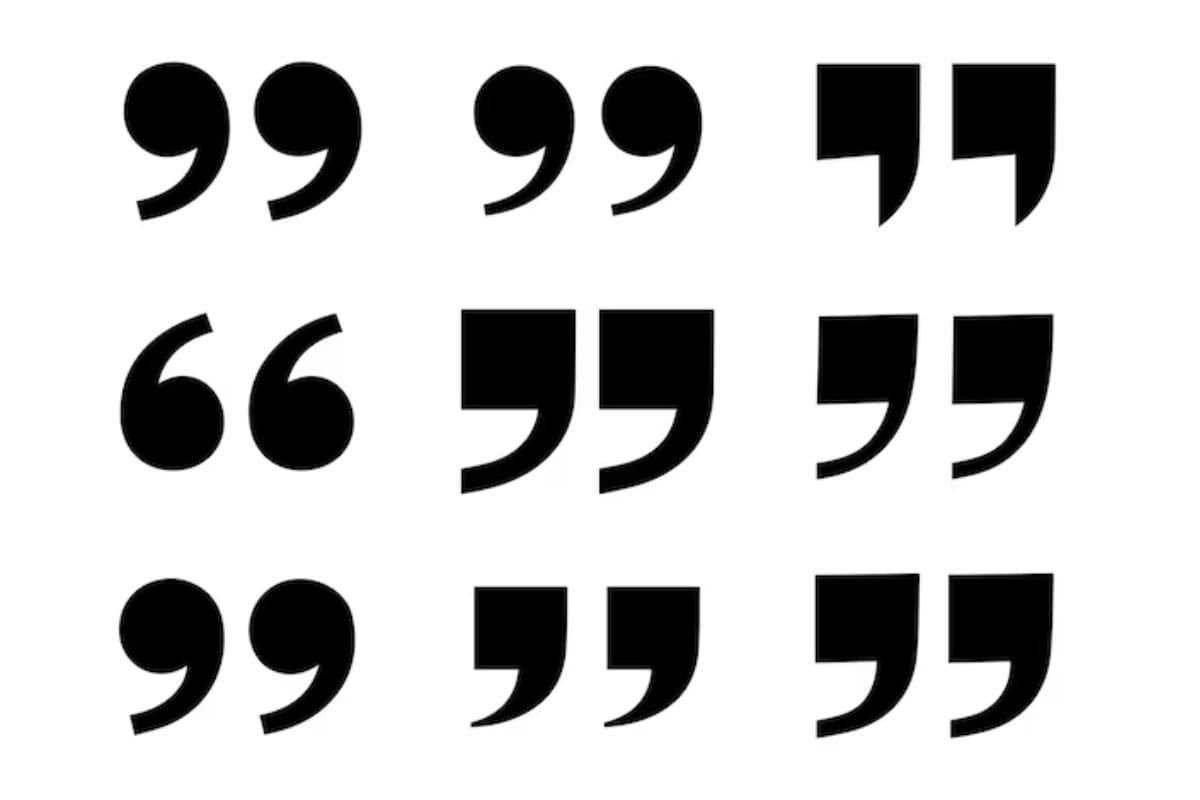Remember that Chris Farley SNL skit where he did news commentary back in ‘94?
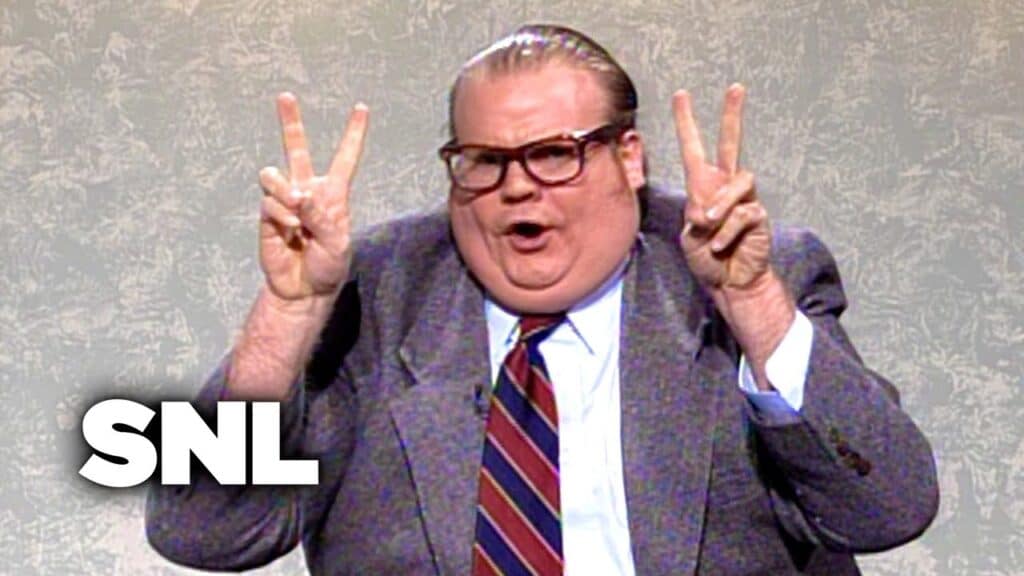
It’s considered a classic and hilariously entertaining, but it’s also a good example of how not to use quotations.
In the skit, the great Chris Farley randomly throws up air quotes for words that don’t actually need them.
And here’s the truth: even experienced writers sometimes struggle with quotation mark practices.
There are several rules that come with it, not just when to use it—but also how.
Could you say he was feeling “tired” after the workout the same way you would call the new policy a “step in the right direction.”
Is it “like this,” or “like this”?
Do periods go inside or outside? When should you use single quotes instead of double quotes?
We’ll walk you through everything you need to know about using quotation marks correctly, with plenty of practical examples to make these rules stick.
Let’s demystify those curly little symbols once and for all.
What Are Quotation Marks?
Quotation marks are punctuation symbols used to set off speech, direct quotations, or certain kinds of titles within text.
They come in two main varieties: double quotation marks (” “) and single quotation marks (‘ ‘).
They tell your reader, “The words inside these marks are different from the rest of the text.”
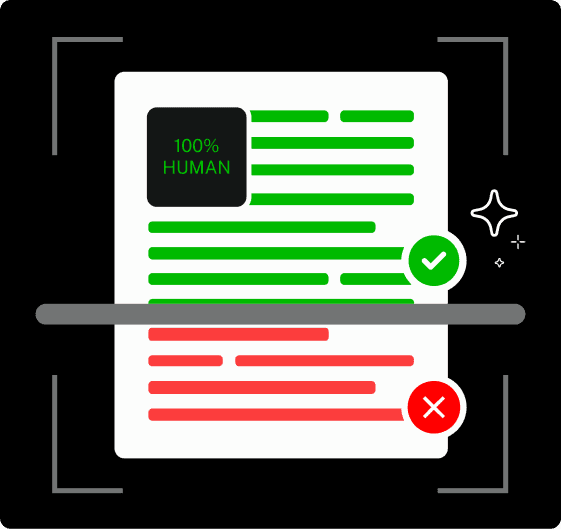
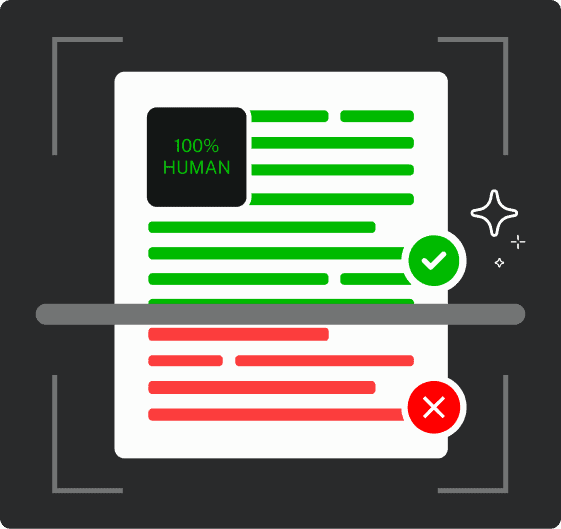
Never Worry About AI Detecting Your Texts Again. Undetectable AI Can Help You:
- Make your AI assisted writing appear human-like.
- Bypass all major AI detection tools with just one click.
- Use AI safely and confidently in school and work.
It basically encloses or sets off exact words.
Maybe you’re quoting someone else’s exact words. Perhaps you’re indicating dialogue in a story.
Or maybe you’re highlighting a specific term or phrase.
Regardless of why you’re using them, quotation marks serve as visual signals that help readers understand your intentions.
They create clarity by showing where the quoted material begins and ends.
While the basic concept seems straightforward, the rules governing quotation marks can be surprisingly nuanced.
Different style guides have different requirements, and usage varies depending on context and the type of writing you’re doing.
Quotation Marks in American vs. British English
One of the first things to understand about quotation marks is that they’re used differently in American and British English.
1. American English primarily uses double quotation marks (” “) for standard quotations and single quotation marks (‘ ‘) for quotes within quotes:
“I was reading ‘The Road Not Taken’ when Sarah called,” explained John.
2. British English traditionally does the opposite, using single quotation marks as the primary form and double quotation marks for quotes within quotes:
‘I was reading “The Road Not Taken” when Sarah called,’ explained John.
This distinction extends to punctuation placement as well.
American English typically places periods and commas inside quotation marks, regardless of whether they’re part of the quoted material:
Tom said, “I’ll be there at noon.”
British English tends to be more logical about this, placing punctuation inside quotation marks only when it’s actually part of the quoted text:
Tom said, ‘I’ll be there at noon’.
If you’re writing for a specific publication or audience, it’s worth checking which convention they prefer.
For academic writing, you’ll typically follow the style guide specified by your institution or publisher (APA, MLA, Chicago, etc.).
When to Use Quotation Marks (With Examples)
Let’s look into the specific situations where quotation marks are required.
Understanding these rules will help you avoid common mistakes and use quotation marks with confidence.
1. Direct Quotations
Use quotation marks to enclose the exact words spoken or written by someone else:
According to the study, “Participants who exercised regularly showed a 25% reduction in stress levels.”
“I’ll pick you up at seven,” said Maria.
Notice that only the actual quoted words go inside the quotation marks.
The attribution (who said it) stays outside.
2. Dialogue in Creative Writing
In stories, novels, and plays, use quotation marks to indicate when characters are speaking:
“Do you think it’s going to rain?” asked Tom, looking up at the gray clouds.
“I’m not sure,” Lucy replied. “But we should bring an umbrella just in case.”
Each new speaker gets a new paragraph, which helps readers follow who’s saying what:
“Where have you been?” demanded his mother.
“Nowhere special,” he mumbled, avoiding her eyes.
“That’s not an answer, young man.”
3. Titles of Short Works
Use quotation marks for titles of shorter works like:
- Short stories: “The Lottery” by Shirley Jackson
- Articles: “Why Sleep Matters” in Scientific American
- Essays: “Once More to the Lake” by E.B. White
- Poems: “The Road Not Taken” by Robert Frost
- Individual episodes of TV shows: “The One Where Ross Got High” from Friends
- Songs: “Bohemian Rhapsody” by Queen
4. Words Used in a Special Way
Use quotation marks to indicate words being used in an unusual, ironic, or otherwise specialized manner:
Her idea of “help” was to rearrange everything in my kitchen.
The term “digital native” refers to someone who grew up using technology.
Be careful not to overuse this technique, as it can come across as unnecessarily sarcastic or heavy-handed.
5. Words as Words
Use quotation marks (or sometimes italics) when referring to a word as a word rather than for its meaning:
The word “affect” is often confused with “effect.”
Why do we say “goodnight” as one word but “good morning” as two?
6. Quotes Within Quotes
When you need to include a quotation inside another quotation, use the alternate form of quotation marks:
In American English (double quotes outside, single quotes inside):
“I distinctly remember her saying, ‘This isn’t up for discussion’ before she left,” recalled Thomas.
In British English (single quotes outside, double quotes inside):
‘I distinctly remember her saying “This isn’t up for discussion” before she left,’ recalled Thomas.
When NOT to Use Quotation Marks
Knowing when to avoid quotation marks is just as important as knowing when to use them.
It makes you a better writer and a more efficient one.
Here are some situations where quotation marks are commonly misused:
When Paraphrasing Instead of Quoting
If you’re putting someone else’s ideas into your own words, don’t use quotation marks:
Incorrect:
Johnson “believes that climate change is the most pressing issue of our time.”
Correct:
Johnson believes that climate change is the most pressing issue of our time.
According to Johnson, climate change represents our most urgent challenge.
If you’re not using the exact words, quotation marks shouldn’t be used.
You still need to cite your source when paraphrasing in academic writing, but without quotation marks.
When Formatting Block Quotes (APA, MLA, Chicago Style)
When quoting a large chunk of text (typically 40+ words or 4+ lines), most style guides recommend using a block quote format instead of quotation marks:
APA Style Block Quote: Block quotes are indented 0.5 inches from the left margin, double-spaced, and don’t use quotation marks.
The citation comes after the final punctuation:
The findings suggest a significant correlation between sleep duration and cognitive performance. Participants who reported sleeping less than six hours per night showed marked decreases in reaction time and decision-making ability. Furthermore, these effects were cumulative, worsening with each consecutive night of insufficient sleep. (Jackson & Lee, 2022, p. 157)
MLA Style Block Quote: MLA also indents block quotes but maintains the same spacing as the rest of the paper:
The findings suggest a significant correlation between sleep duration and cognitive performance. Participants who reported sleeping less than six hours per night showed marked decreases in reaction time and decision-making ability. Furthermore, these effects were cumulative, worsening with each consecutive night of insufficient sleep. (Jackson and Lee 157)
Chicago Style Block Quote: Chicago style indents block quotes and may use smaller font size:
The findings suggest a significant correlation between sleep duration and cognitive performance. Participants who reported sleeping less than six hours per night showed marked decreases in reaction time and decision-making ability. Furthermore, these effects were cumulative, worsening with each consecutive night of insufficient sleep.¹
When Using Emphasis (Use Italics Instead)
One of the most common misuses of quotation marks is for emphasis:
Incorrect:
This product is “guaranteed” to work!
Correct:
This product is guaranteed to work!
Using quotation marks for emphasis actually achieves the opposite effect—it suggests skepticism or irony about the enclosed term.
If you want to emphasize something, use italics, bold text, or rethink your sentence structure to naturally emphasize the important elements.
Common Mistakes with Quotation Marks (+How to Fix Them)
Even experienced writers make mistakes with quotation marks.
Here are some of the most common errors and how to correct them:
Mistake #1: Using quotation marks for emphasis
As mentioned above, this is perhaps the most widespread misuse of quotation marks.
When you put quotation marks around a word for emphasis, you’re actually suggesting that the term is being used ironically or isn’t what it claims to be.
Incorrect:
Our “fresh” bread is baked daily.
This unintentionally suggests the bread might not actually be fresh.
Correct:
Our fresh bread is baked daily.
Mistake #2: Punctuation placement errors
In American English, commas and periods always go inside the quotation marks, even if they weren’t part of the original quotation.
Question marks and exclamation points go inside only if they’re part of the quoted material.
Incorrect:
She said she was “tired”, then went to bed.
Correct:
She said she was “tired,” then went to bed.
Mistake #3: Inconsistent use of single and double quotation marks
Switching between single and double quotation marks inconsistently creates confusion.
Incorrect:
“The article ‘Climate Change: A New Perspective’ mentions several ‘key factors’ that scientists are currently researching,” explained Dr. Lee.
Correct:
“The article ‘Climate Change: A New Perspective’ mentions several ‘key factors’ that scientists are currently researching,” explained Dr. Lee.
Mistake #4: Using quotation marks with indirect quotes
Indirect quotes or paraphrases should not be in quotation marks.
Incorrect:
The CEO “explained that the company would be restructuring over the next quarter.”
Correct:
The CEO explained that the company would be restructuring over the next quarter.
Mistake #5: Forgetting to close quotation marks
Always make sure each opening quotation mark has a corresponding closing mark.
Incorrect:
“Let’s meet at the cafe, he suggested.
Correct:
“Let’s meet at the cafe,” he suggested.
How AI Can Help Improve Your Use of Quotation Marks
Many AI content creation and writing tools have become increasingly sophisticated in helping writers with grammar, punctuation, and style.
When it comes to quotation marks specifically, AI can offer valuable assistance.
Undetectable AI’s Ask AI and AI Chat tools provide immediate feedback on quotation mark usage.

Simply input a sentence or paragraph you’re unsure about, and the AI will identify any quotation mark errors and explain the correct usage.
For example, if you ask: “Is this correct: She described the event as “life-changing”, and then moved on to another topic.”
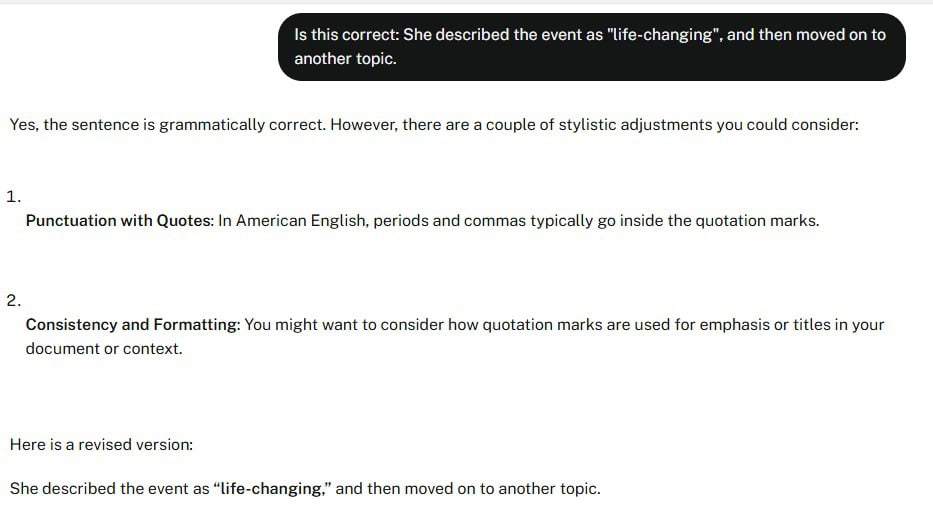
The AI chat correctly identified the punctuation rule for quotation marks in American English and provided a clear correction.
It also advised checking for consistency in how quotation marks are used for emphasis.
Another tool to add to your arsenal, whether you’re a student writing an informative essay or someone looking to refine their grammar, is Undetectable AI’s Essay Writer.
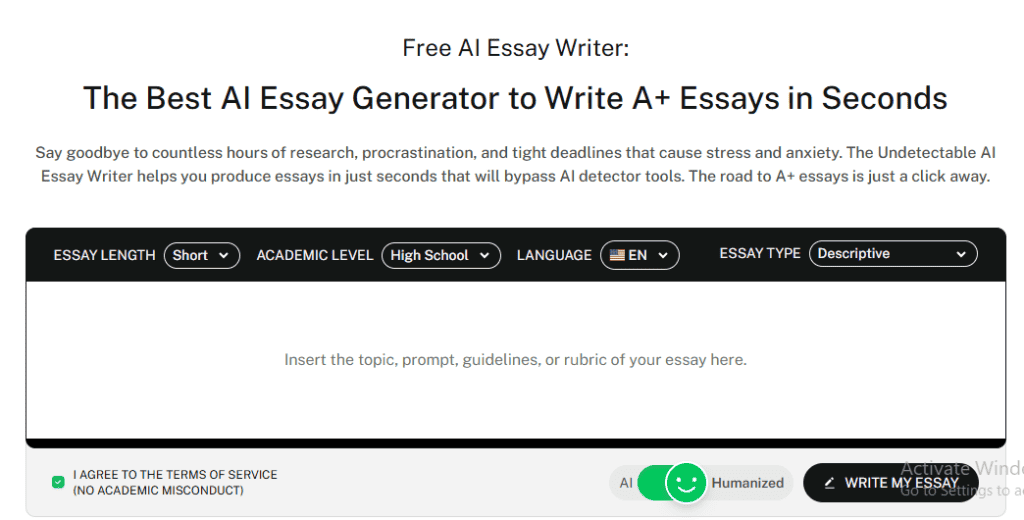
Just enter the topic, select the essay type, and adjust the length and academic level.
The essay writer will generate a structured essay covering quotation mark rules, common mistakes, and examples.
If you need refinements, Ask AI provides real-time feedback to ensure accuracy and proper formatting.
You can also explore our AI Detector and Humanizer in the widget below:
FAQs About Quotation Marks
When should I use single vs. double quotation marks?
In American English, use double quotation marks (” “) and single (‘ ’) for quotes within quotes. In British English, it’s reversed. Follow style guides like APA, MLA, or Chicago when needed.
Where does the period go in a quotation?
“I’ll be there soon,” she promised. In British English, they go inside only if part of the original quote: She called the proposal ‘ridiculous’.
Do I use quotation marks for titles of books and movies?
No, books, movies, and newspapers should be italicized: To Kill a Mockingbird. Use quotation marks for short works: “The Raven,” “Dinner Party” (The Office).
Can I use quotation marks for emphasis?
No, they suggest skepticism or irony:
❌ This is a “real” diamond.
✅ This is a real diamond. Use italics or bold instead.
When should I use quotation marks vs. italics?
Use quotation marks for:
Direct speech
Titles of short works (articles, poems, songs)
Special/ironic terms
Words as words (The word “affect” is tricky.)
Use italics for:
Titles of long works (books, movies, plays)
Emphasis
Foreign words (et cetera)
Scientific names (Homo sapiens)
Ship names (Titanic)
“The Final Word” on Quotation Marks
Quotation marks have clear rules, and mastering them takes practice.
Use double quotes in American English, single for quotes within quotes, and keep punctuation inside in the U.S. Don’t use them for emphasis or paraphrasing.
And if you ever feel like Chris Farley throwing up random air quotes, don’t worry—we’ve all been there.
When in doubt, let Undetectable AI check your writing. Our AI tools catch errors, ensure consistency, and make proper usage effortless.
Try them today.
